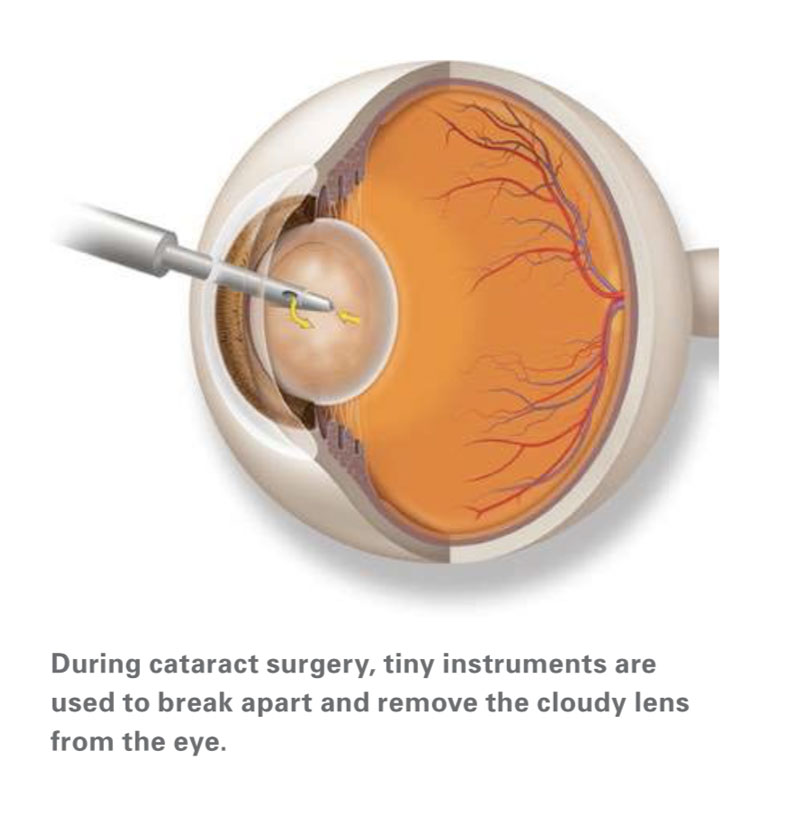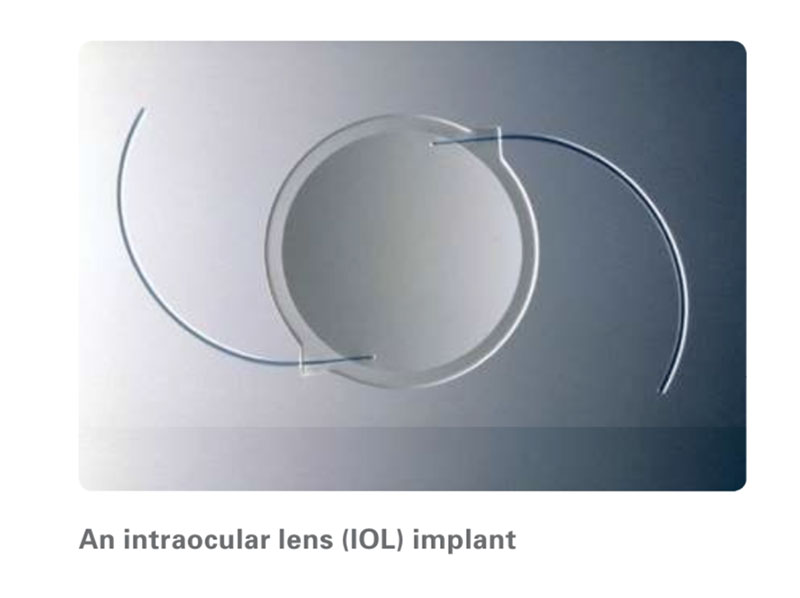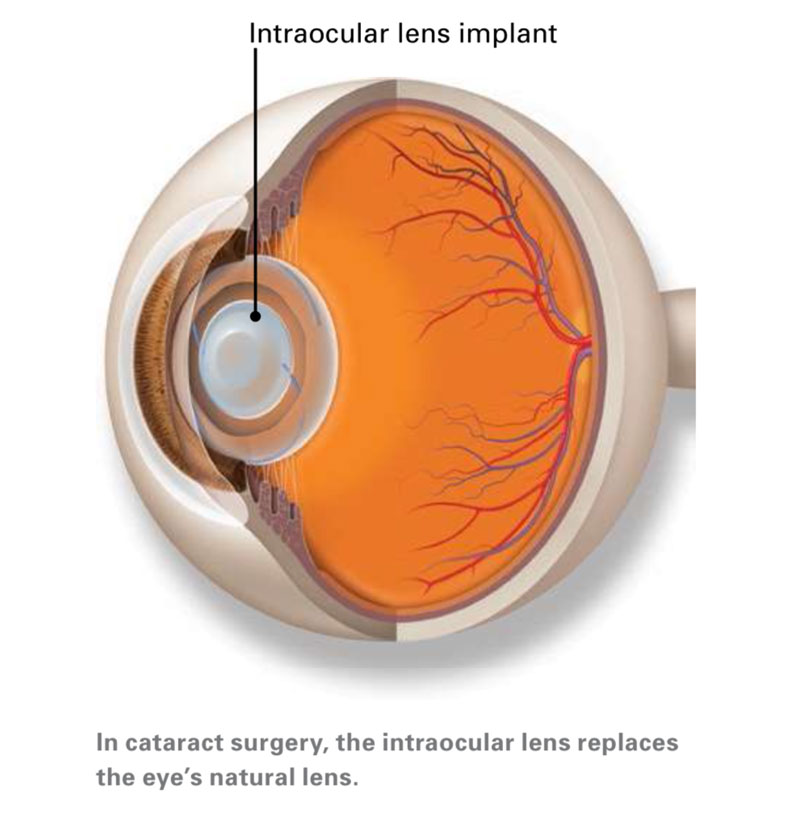No Gap Cataract Surgery
Cataract surgery is one of the most effective and safe procedures in modern medicine. Cataract operation is a surgical procedure that removes your eye’s lens when it becomes cloudy and interfering with the quality of your vision.
Dr John Chang is pleased to provide "No Gap" cataract surgery for his insured pensioner patients and "Known Gap" eye surgery for other patients with private health (hospital cover) insurance policy. This means that his patients will incur either zero or only a small, fixed (known) out of pocket cost for their cataract surgery.

Image from American Academy of Ophthalmology: Cataract Surgery

Image from American Academy of Ophthalmology: Cataract Surgery

Image from American Academy of Ophthalmology: Cataract Surgery
What is cataract surgery?
Cataract operation is a microsurgical procedure to remove your eye’s lens when it becomes cloudy and interferes with the quality of your vision. It is one of the most effective and safe procedures in modern medicine. During cataract surgery, your cloudy lens is carefully removed under the high-resolution 3D view of an operating microscope and replaced with a clear artificial lens, called an intraocular lens (IOL) implant. Modern cataract surgery uses technology such as phacoemulsification (using ultrasonic energy) and/or laser (femtosecond laser-assisted cataract surgery or FLACS).
Prior to the operation, in the clinic, your ophthalmologist will measure your eye using specialized equipment (ocular biometry) to determine what type and strength (focusing power) of intraocular lens you need. The IOL selected to be implanted in your eye is “custom fit” to the shape and size of your eye, with the aim of providing you with improved eyesight and without the need for glasses for some or most situations. The accuracy of ocular biometry measurements and tailored discussion with the patient about suitable IOL options is very important, and Dr John Chang takes meticulous care with respect to this using the latest technology available. At Eastwood Eye Specialists, we use at least 2 different modalities of measuring your eye as part of this detailed pre-operative assessment including the industry leading Zeiss IOL Master 700 with corneal topography as well as other advanced technology such as OCT-guided corneal topography and biometry.
Glaucoma is another relatively common eye disease associated with ageing and often co-exists in patients with cataract. Some patients with both cataract and glaucoma may benefit from cataract surgery combined with a glaucoma stent implant (such as micro-trabecular bypass stent). This is called Micro Invasive Glaucoma Surgery (MIGS) and when combined with cataract operation, it helps to improve both the patient’s eye sight and also lower the eye pressure for better control of their glaucoma. This is a relatively new surgical technique that has been proven to be both safe and effective, and Dr Chang offers this to suitable patients.
What to expect with cataract surgery
Cataract operation is very safely and comfortably performed as a day surgery procedure, and so you will only be admitted to the hospital for several hours and be discharged back home on the same day (ie. you do not need to stay overnight in hospital).
- The operation is performed under local anaesthesia, meaning that your eye will be numbed with eye drops and a local anaesthetic block around the eye. You will also be given medicine by the specialist anaesthetist to help you relax.
- You will be awake during the surgery, however you can be assured that you will be relaxed and comfortable. You will be aware of some sound, light and movement during the procedure, but you will not see what the doctor is doing to your eye and the procedure will be pleasant and there will be no discomfort at all. You will be lying flat on your back, and some drape will be placed over your face and to keep the operation site clean.
- The eye operation itself will take about 30 minutes. For this “key hole” microsurgery, your eye surgeon will gain access into the eye through tiny incisions (cuts of only few millimetres in length, created by laser or a blade) near the edge of your cornea (the clear window covering the front of your eye). The surgeon uses these incisions to reach the cloudy lens in your eye. Using very small instruments, he will break up the lens with the cataract and remove it. Then your new lens (IOL) is inserted into place.
- Cataract surgery is “sutureless”, meaning that there is usually no need to stitch these tiny incisions closed. These “self sealing” micro-incisions eventually heal by themselves over time. A clear plastic shield will be temporarily placed over your eye to protect it whilst you heal from the surgery.
- Recovery from cataract surgery is rapid and there is minimal down-time. Often the eye sight will be bright and clear from the very first day after surgery, but there is usually continuing improvement in the eye sight over the first 1-2 weeks after the operation. For the first couple of days, the eye can feel a bit gritty and watery, but usually there is no discomfort or pain and patients are often driving and working within a few days of the surgery.
- Post-operative eye drops are required after the surgery. They are usually instilled 4 times a day initially and are required for a total of 4 weeks. Be sure to carefully follow your doctor’s instructions for using these drops.
- Avoid strenuous activity such as heavy lifting, bending over, or excessive coughing for the first week after surgery. Do not rub or press on your eye. You will need to wear a protective eye shield when you sleep for the first week.
- Scheduled post-operative clinic visits will be provided so that your progress and recovery after the surgery can be carefully monitored and supervised. Any concerns or unforeseen problems that may rarely arise will be addressed promptly. Dr Chang also gives his own personal phone number to his surgery patients, so that he can be reached for advice at any time, including after hour or over the weekend.
What are the lens or IOL options in cataract surgery?
An intraocular lens (IOL) is, by necessity, required to replace the eye’s natural lens that is removed during cataract surgery. IOL is a tiny, artificial plastic lens for the eye and they come in different focusing powers and shapes, just like prescription eye glasses or contact lenses.
There are various types of IOLs that are available for implantation during cataract surgery. All IOLs have their pros and cons, and currently there is no “perfect” IOL for everyone. The choice of the type of IOL depends on the individual person’s visual needs and wants, and how it fits into their lifestyle. This must be discussed with your eye surgeon before the operation itself.
Types of IOL or focusing (refractive) outcome goals include:
- Monofocal IOL: This has one focusing distance. It may be set to focus for distance vision or up close for reading. Most people have them set for clear distance vision so that they do not need glasses for driving or watching the TV. They would then wear reading glasses for close work or fine print.
- Monovision outcome: Here, one eye (the dominant eye) is set to focus for distance vision with a monofocal IOL, whilst the other eye (the non-dominant eye) is set to focus for near vision. This allows suitable patients to enjoy both distance and near vision without the need for glasses. Some patients have already had “monovision” in their contact lenses prescription, and such persons are ideal candidates for this when they have their cataract surgery.
- Toric IOL: This lens corrects for “astigmatism”, which is a refractive error caused by an uneven curve in your cornea (the front window of the eye). It is generally recommended to correct any corneal astigmatism that is present with the various IOL options that are available.
- Multifocal IOL: These lenses have different focusing powers within the same lens. It splits the light coming into the eye to provide both distance, intermediate and near focus at the same time. These IOLs may be suitable for patients who are highly motivated to have reduced dependence on glasses. However, there are downsides to this type of IOL including haloes, glare, and reduced contrast sensitivity. For example, they are generally a bad choice for someone who does driving at night time.
- Extended depth of focus (EDOF) IOL: These are newer IOL technology that aims to provide a more extended range of sharp vision and a lower incidence of halo and glare. EDOF lenses have been designed in an attempt to overcome some of the well recognized disadvantages of multifocal IOLs. These IOLs differ from multifocal IOLs as they create a more continuous range of near vision instead of multiple points of focus.
What are the risks of cataract surgery?
Cataract surgery is very safe and has a very high success rate, however, like any surgery, it does carry potential risks of problems or complications. It is vital that prospective patients have a balanced discussion and understanding of these issues that are carefully explained by their treating eye surgeon without causing unnecessary fear or anxiety. Some of these potential complications include eye infection (around 1 in 1,000 chance), bleeding in the eye, pain, vision loss, retinal problems such as swelling or retinal detachment, or a need for a second operation. These are uncommon to rare problems, and even if they do occur, they are often treatable. There is no substitute for a detailed and tailored discussion with your eye surgeon about all the potential risks that may apply to most people and also if there are pertinent issues to your eye specifically. For example, patients with other co-existing eye conditions such as diabetic retinopathy, glaucoma, uveitis or prior retinal detachment, have other additional issues that need to be addressed.
Why choose Dr John Chang as your cataract surgeon?
Dr Chang is a highly experienced and skilled cataract surgeon who has performed thousands of eye operations. He regularly audits his surgical results and outcomes. His special interests include cataract surgery in more complex situations such as patients with diabetic retinopathy, glaucoma, and uveitis.
Dr Chang puts meticulous attention to his patient’s eyes from even before the surgery as well as of course during the operation itself and during the post-operative aftercare. His track record of surgical outcome of the highest standard and the word-of-mouth referrals from his happy patients to their family and friends is the ultimate testament to the quality of care he provides.
Eastwood Eye Specialists invests in the latest technology to ensure the most accurate and precise measurements and imaging of your eyes are obtained, which is another important aspect of achieving the best refractive and surgical outcome with cataract operation.
What are the costs of cataract surgery?
The cost of cataract surgery in the private hospital is determined by various factors and should be discussed with the eye surgeon and his clinic staff. As a general guide, the fees associated with surgery can be divided into the surgeon’s fee, anaesthetist’s fee and the private hospital’s facility fee (which includes the use of their specialized equipment to perform the surgery as well as the intraocular lens implant, and the expertise of the theatre nurses). These fees can vary depending on numerous factors as each doctor, hospital and private health insurance funds all set their own fees and rebates.
It is important to have a thorough discussion of the fees and estimates of any out of pocket expenses before the surgery is booked. This is called “informed financial consent”, and patients should ensure that they fully understand this and are comfortable with the explanation provided.
Dr John Chang is pleased to provide “No Gap” cataract surgery for his insured pensioner patients and "Known Gap" eye surgery for other patients with private health (hospital cover) insurance policy. This means that his patients will incur either zero or only a small, fixed (known) out of pocket cost for their cataract surgery.
Dr Chang is able to offer a limited number of free cataract surgery for uninsured pensioners in financial hardship through the generosity of Dr Knight’s Medi-Aid charity program. Further information and eligibility criteria can be explained by Dr Chang and his staff, but this does involve eye registrar currently in training (as part of accredited Sydney Eye Hospital program) to be performing the operation under the supervision of Dr Chang as the consultant in charge.
For more information on no gap cataract surgery, please call Eastwood Eye Specialists for an appointment.